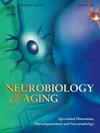Alcohol consumption confers lasting impacts on prefrontal cortical neuron intrinsic excitability and spontaneous neurotransmitter signaling in the aging brain in mice
IF 3.5
3区 医学
Q2 GERIATRICS & GERONTOLOGY
引用次数: 0
Abstract
Both alcohol use disorder (AUD) and cognitive decline include disruption in the balance of excitation and inhibition in the cortex, but the potential role of alcohol use on excitation and inhibition on the aging brain is unclear. We examined the effect of moderate voluntary binge alcohol consumption on the aged, pre-disease neuronal environment by measuring intrinsic excitability and spontaneous neurotransmission on prefrontal cortical pyramidal (excitatory, glutamatergic) and non-pyramidal (inhibitory, GABAergic) neurons following a prolonged period of abstinence from alcohol in mice. Results highlight that binge alcohol consumption has lasting impacts on the electrophysiological properties of prefrontal cortical neurons. A profound increase in excitatory events onto layer 2/3 non-pyramidal neurons following alcohol consumption was seen, along with altered intrinsic excitability of pyramidal neurons, which could have a range of effects on cognitive disorder progression, such as Alzheimer’s Disease, in humans. These results indicate that moderate voluntary alcohol influences the pre-disease environment in aging and highlight the need for further mechanistic investigation into this risk factor.
饮酒对小鼠衰老大脑前额叶皮质神经元固有兴奋性和自发神经递质信号转导产生持久影响。
酒精使用障碍(AUD)和认知能力下降都包括大脑皮层兴奋和抑制平衡的破坏,但酒精使用对老化大脑兴奋和抑制的潜在作用尚不清楚。我们通过测量小鼠长期戒酒后前额叶皮层锥体(兴奋性,谷氨酸能)和非锥体(抑制性,GABA能)神经元的内在兴奋性和自发神经传递,研究了中度自愿暴饮对老化、病前神经元环境的影响。研究结果表明,酗酒会对前额叶皮质神经元的电生理特性产生持久影响。饮酒后,第 2/3 层非锥体神经元的兴奋事件显著增加,锥体神经元的固有兴奋性也发生了改变,这可能会对人类认知障碍(如阿尔茨海默病)的发展产生一系列影响。这些结果表明,适度自愿饮酒会影响衰老过程中的病前环境,并强调了对这一风险因素进行进一步机理研究的必要性。
本文章由计算机程序翻译,如有差异,请以英文原文为准。
求助全文
约1分钟内获得全文
求助全文
来源期刊

Neurobiology of Aging
医学-老年医学
CiteScore
8.40
自引率
2.40%
发文量
225
审稿时长
67 days
期刊介绍:
Neurobiology of Aging publishes the results of studies in behavior, biochemistry, cell biology, endocrinology, molecular biology, morphology, neurology, neuropathology, pharmacology, physiology and protein chemistry in which the primary emphasis involves mechanisms of nervous system changes with age or diseases associated with age. Reviews and primary research articles are included, occasionally accompanied by open peer commentary. Letters to the Editor and brief communications are also acceptable. Brief reports of highly time-sensitive material are usually treated as rapid communications in which case editorial review is completed within six weeks and publication scheduled for the next available issue.
 求助内容:
求助内容: 应助结果提醒方式:
应助结果提醒方式:


